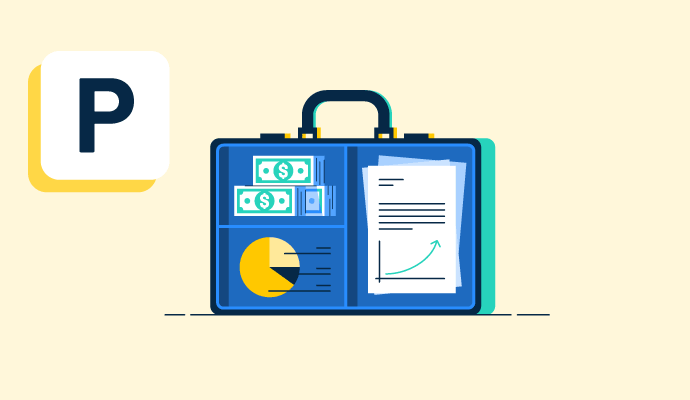What is portfolio management?
Portfolio management supervises investments within a portfolio that meet long-term financial objectives. It involves building a complete picture of bonds, stocks, and cash investments. Portfolio management is concerned with understanding how to pair the right investments for a client to attain financial goals while balancing the level of risk.
Investment professionals use investment portfolio management software to track client investments. These tools allow advisors and portfolio managers to see a holistic view of investment activities on behalf of their clients so they can easily keep track of all relevant data.
Types of portfolio management
Investors rely on four types of portfolio management, usually differentiated by level of involvement.
- Active portfolio management strategies require constant evaluation of market trends, economic shifts, and political changes that might affect assets. The goal is to outperform the market to achieve superior returns. Generally, this strategy requires greater market risk and is best suited for experienced investors.
- Passive portfolio management, also known as index fund management, mimics a benchmark or index to match its performance as closely as possible. A passive portfolio management strategy aims to generate a return similar to the chosen index while being more hands-off than an active strategy. Investors who want to minimize risk tend to lean toward a passive approach over an active one.
- Discretionary portfolio management gives portfolio managers or fund managers total control over their clients’ investments. The portfolio manager can buy and sell assets on behalf of their clients without consent for each trade and requires extensive knowledge and investment experience.
- Non-discretionary portfolio management operates similarly to financial advice by laying out the pros and cons of an investment. However, the portfolio manager cannot execute any investments without consent from the investor.
Types of assets in portfolio management
An investor might want to rely on employer-sponsored assets. Another may focus on cryptocurrencies. Someone else could be dedicated to cash. The kinds of assets in a portfolio are dictated by strategy and investor goals. Different types of assets may be part of the portfolio. Some of the common types of assets include:
- Stocks. Investors receive shares in a public company when they buy stocks. As the company grows, the value of the purchased shares appreciates. Growth, value, dividend, and blue-chip are examples.
- Bonds. When investors purchase a bond, they lend money to the issuer; in exchange, the issuer pays interest. Additionally, the issuer returns the original investment once the bond reaches its maturity date. Bonds are considered to be less risky than stocks.
- Cash. A cash investment or cash equivalent is a short-term investment known for stabilizing investment portfolios. A treasury bill, or a T-bill, is an example of a cash investment.
- Mutual funds. These types of investments pool money from investors to invest in groups of stocks and bonds. Financial professionals typically manage mutual funds, including stock mutual funds, bond mutual funds, and balanced funds.
- Index funds. This is a form of a mutual fund, but index funds are passively managed. Generally, they are available through employer-sponsored retirement plans and brokerage accounts.
- Exchange traded funds (ETFs). Like mutual funds, ETFs pool money from investors to purchase stocks and bonds. They’re bought and sold on market exchanges.
- Annuities. An annuity is a contractual agreement between individuals and insurance companies in which the individual pays the insurance company in installments or a lump sum. In return, the insurance company makes periodic payments for the individual for a set period. The three main types of annuities are fixed, variable, and index.
- Cryptocurrencies: Popular in recent years, cryptocurrencies are sometimes viewed as an investment asset. It’s important to note that cryptocurrencies are risky and not regulated like other investment assets.
Benefits of portfolio management
Finding the correct portfolio manager is crucial for meeting financial goals within a portfolio. Some of the benefits of portfolio management with the right portfolio manager in the mix include:
- Better investment decisions. Portfolio managers guide investors to the right assets. With their knowledge and expertise, they offer informed investment advice, so clients meet their goals and objectives.
- Liquidity management and oversight. A portfolio management strategy structures investments logically. Portfolio managers advise their clients about the diversification of assets to prepare them for emergencies in which they need to sell investments quickly.
- Higher returns. Portfolio management is designed to grow an investor’s capital. A portfolio manager provides a structured framework for each investor and helps them select the best assets to earn higher returns.
Portfolio management best practices
Managing a portfolio of investments requires commitment and dedication to the process. Individuals should consider the following best practices to take charge of their finances.
- Define financial goals. Good portfolio management means setting goals and sticking to them.
- Consider the risk involved. Investors have varying risk tolerance levels based on their finances, commitments, and security. Individuals must be honest about their willingness to sacrifice to ensure alignment with potential partners.
-
Hire a portfolio manager. The right portfolio manager helps investors diversify their portfolios and make informed decisions for greater returns. Investors should seek advice when needed and determine how hands-on they can be with their investments.
Looking for a long-term strategy for growing wealth? Learn about shareholders’ equity and how it can be a wise investment.

Alyssa Towns
Alyssa Towns works in communications and change management and is a freelance writer for G2. She mainly writes SaaS, productivity, and career-adjacent content. In her spare time, Alyssa is either enjoying a new restaurant with her husband, playing with her Bengal cats Yeti and Yowie, adventuring outdoors, or reading a book from her TBR list.




















